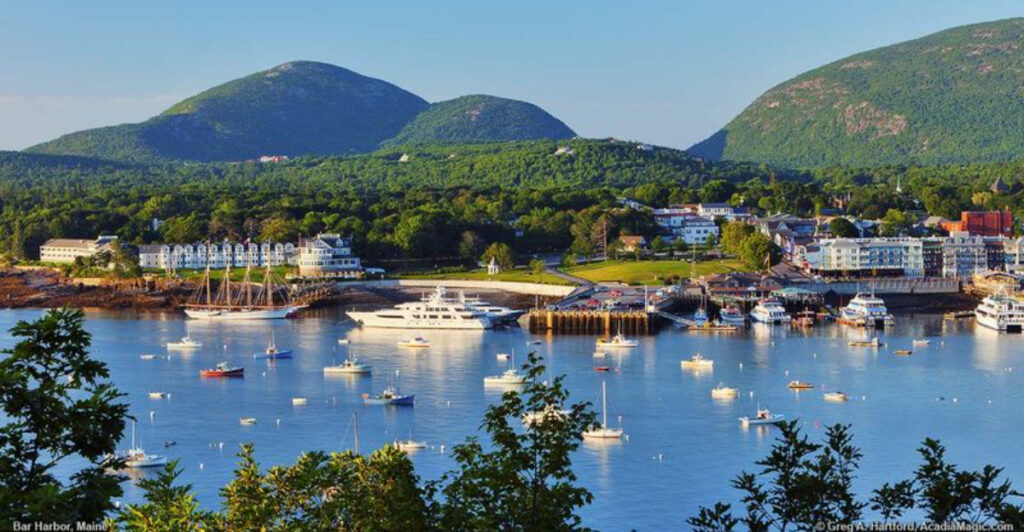America’s shorelines are dotted with charming coastal communities that capture the heart with their unique blend of natural beauty and small-town character. From rugged Pacific cliffs to sandy Atlantic shores, these seaside gems offer everything from historic architecture to fresh seafood and stunning ocean views. Pack your beach bag and join us as we explore the most picturesque waterfront towns across the country.
1. Kennebunkport, Maine

Presidential retreats and lobster traps define this classic New England fishing village. The Bush family compound at Walker’s Point stands as a silent sentinel overlooking the Atlantic, while downtown Dock Square buzzes with activity. Salt-weathered shingles adorn historic captain’s homes that line tree-shaded streets, telling stories of maritime wealth from centuries past. Local fishermen still bring their daily catch to harborside restaurants, where diners feast on lobster rolls and clam chowder at tables overlooking the water. Goose Rocks Beach stretches three miles with powder-soft sand—a rarity on Maine’s predominantly rocky coast. When autumn arrives, the surrounding maple trees burst into fiery colors, creating a stunning contrast against the deep blue ocean.
2. Rehoboth Beach, Delaware
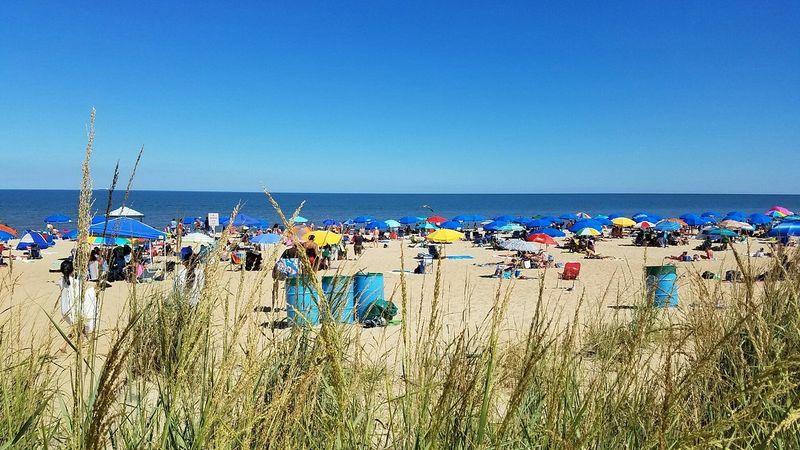
Fondly nicknamed “The Nation’s Summer Capital” due to its popularity with Washington DC vacationers, Rehoboth Beach delivers nostalgic boardwalk charm without the overwhelming crowds of larger resort towns. The mile-long boardwalk dates back to 1873 and remains the heart of this lively community. Colorful beach umbrellas dot the clean, wide shoreline where families build sandcastles and cool off in the Atlantic waves. Beyond the beach, Rehoboth Avenue features tax-free shopping at unique boutiques housed in Victorian-era buildings. Local legend claims the town’s name comes from a Biblical reference meaning “room enough for all”—fitting for a community known for its welcoming atmosphere. The tantalizing aroma of Thrasher’s French fries, a regional favorite since 1929, wafts through the salt air.
3. Bethany Beach, Delaware
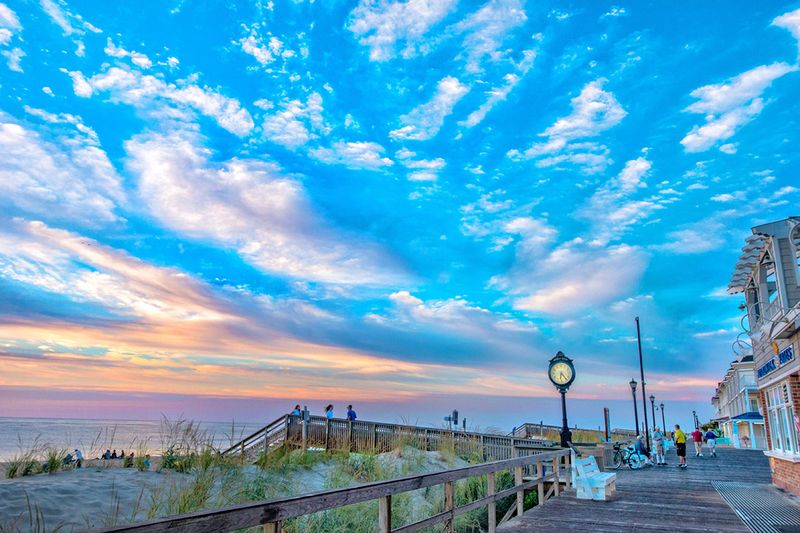
Nicknamed “The Quiet Resort,” Bethany Beach offers a peaceful alternative to its livelier coastal neighbors. Morning sunrises paint the sky in watercolor hues, greeting early walkers on the half-mile boardwalk lined with benches perfect for ocean gazing. The town’s charm lies in its intentional small-scale development, with a 40-foot height restriction preserving its intimate feel. Families return generation after generation, creating summer traditions around beach days and evening strolls for ice cream at Kohr Bros, a local institution. Nearby Salt Pond serves as a gateway to Delaware Seashore State Park, where nature trails wind through coastal marshlands teeming with herons and egrets. The town’s totem pole, carved with scenes of local history, stands as a unique landmark in the downtown area.
4. Nags Head, North Carolina
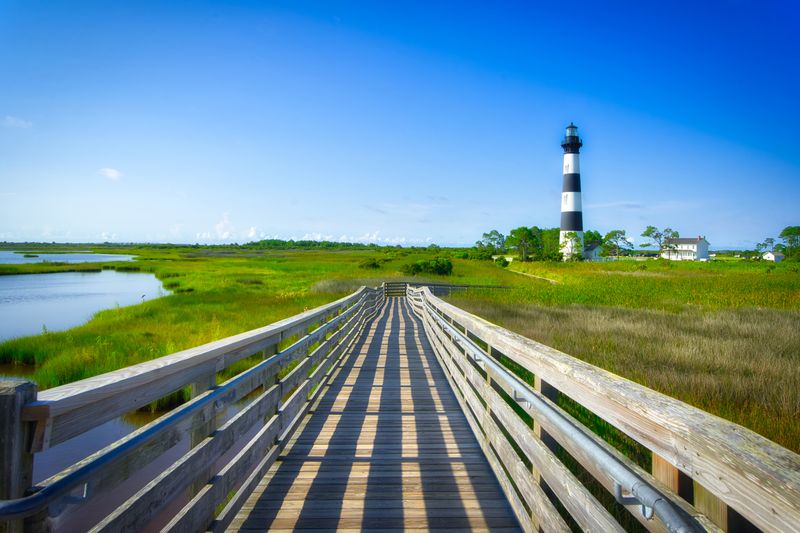
Ancient live oaks twisted by centuries of Atlantic winds stand sentinel over Nags Head’s spectacular dunes. This Outer Banks treasure balances wild natural beauty with seaside comfort, anchored by the iconic Bodie Island Lighthouse with its distinctive black-and-white horizontal stripes. Jockey’s Ridge, the tallest natural sand dune system in the eastern United States, creates an otherworldly landscape where hang gliders launch into ocean breezes. The town got its unusual name from the colonial practice of hanging lanterns on horses’ necks to lure ships to shore—a pirate’s trick. Weathered fishing piers stretch into the surf, while historic cottages known as the “Unpainted Aristocracy” showcase the distinctive Nags Head architectural style with wraparound porches designed to catch sea breezes from every direction.
5. Bar Harbor, Maine
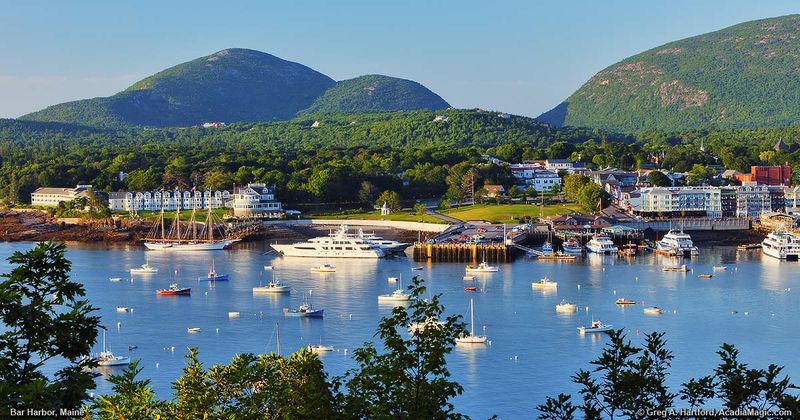
Perched at the gateway to Acadia National Park, Bar Harbor combines wild natural beauty with New England charm. Morning fog rolls dramatically across the rocky coastline, creating a mystical atmosphere that photographers chase year-round. The town’s historic streets reveal colorful boutiques and cozy cafés where lobster is always on the menu. Summer brings kayakers and whale watchers to the harbor, while fall paints the surrounding forests in brilliant hues. At low tide, a natural sand bar appears, connecting the mainland to Bar Island—a local phenomenon that gives the town its name. With its perfect balance of outdoor adventure and small-town hospitality, Bar Harbor represents the quintessential Maine experience.
6. Virginia Beach, Virginia
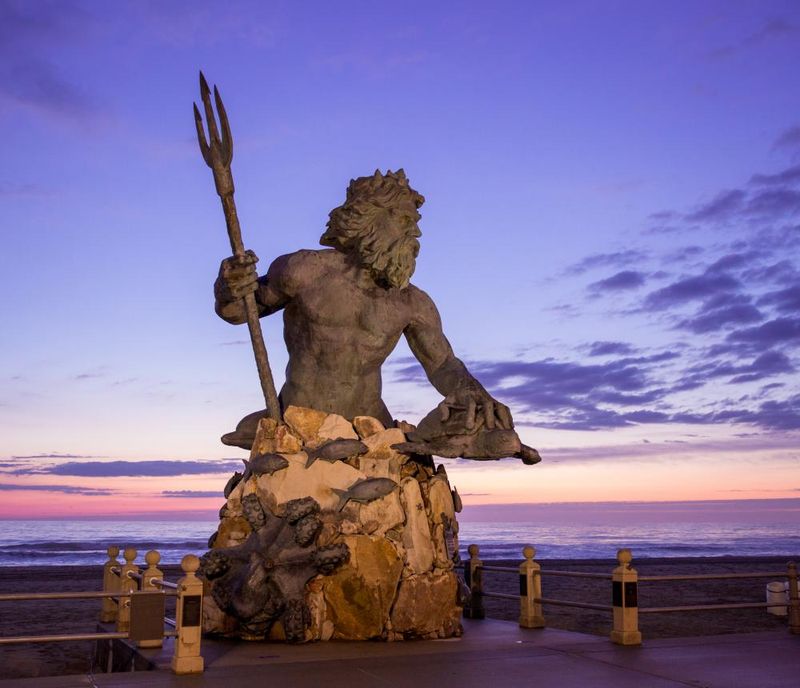
Holding the Guinness World Record for the longest pleasure beach in the world, Virginia Beach blends resort energy with military heritage. The iconic King Neptune statue—a 34-foot bronze giant—guards the entrance to Neptune’s Park, becoming the most photographed spot along the three-mile boardwalk. Morning reveals dolphins playing in the surf as joggers and cyclists traverse the dedicated path alongside the beach. The historic Cavalier Hotel stands as a grand dame overlooking the shore, having hosted ten U.S. presidents and celebrities like F. Scott Fitzgerald since opening in 1927. Beyond the bustling oceanfront lies the serene beauty of First Landing State Park, where English colonists first set foot in 1607 before establishing Jamestown. Local restaurants serve fresh Lynnhaven oysters—a delicacy prized since colonial times for their distinctive sweet flavor.
7. Chincoteague, Virginia
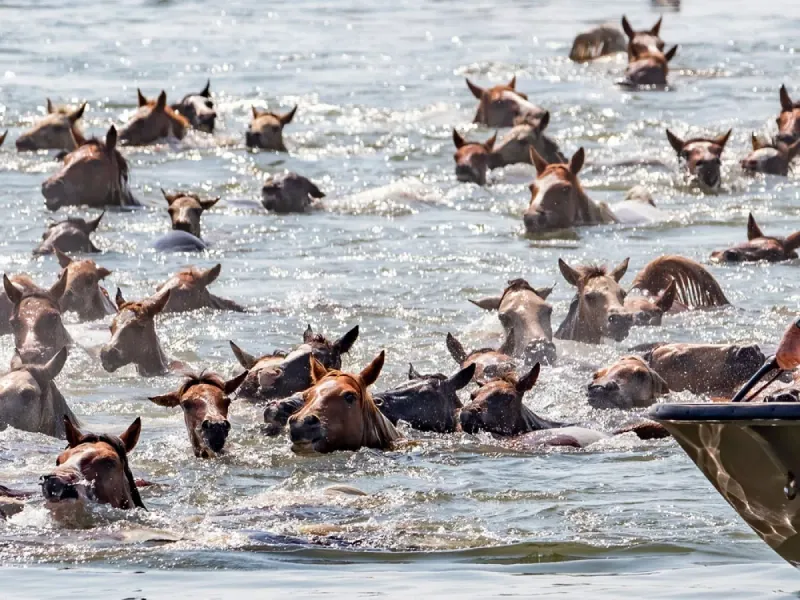
Wild ponies roam free on this enchanted barrier island, made famous by Marguerite Henry’s beloved children’s book “Misty of Chincoteague.” The annual Pony Swim draws thousands who watch as the horses make their legendary swim across the channel—a tradition since 1925. Unlike many beach towns, Chincoteague embraces a slower pace with no high-rises or boardwalk. Instead, visitors find miles of undeveloped beaches within the Chincoteague National Wildlife Refuge, where more than 320 bird species create a birdwatcher’s paradise. The town’s working watermen still harvest the famous Chincoteague oysters and clams from surrounding waters. Sunset brings spectacular views across the marshlands, where the sky explodes with color reflected in countless tidal pools, creating natural mirrors that double the visual magic.
8. Cape May, New Jersey
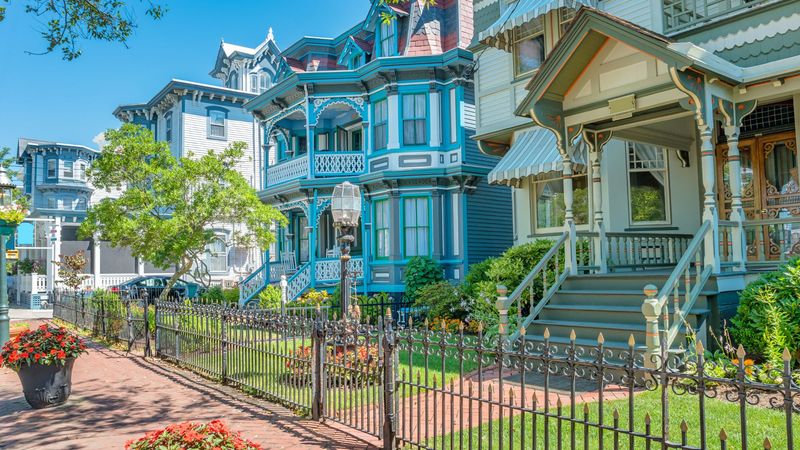
America’s original seaside resort boasts the largest collection of Victorian gingerbread houses in the country, their candy-colored exteriors adorned with intricate wooden trim. Horse-drawn carriages clip-clop down gas-lit streets, passing homes with names rather than numbers—a charming throwback to the town’s 19th-century heyday. Cape May’s beaches offer a gentler surf than many Jersey Shore destinations, making them perfect for families. The town sits at a unique geographical position where the Delaware Bay meets the Atlantic Ocean, creating a premier spot for dolphin and whale watching. Local folklore claims numerous friendly ghosts inhabit the historic inns and bed-and-breakfasts. The iconic Cape May Lighthouse has guided mariners since 1859, while the surrounding wetlands provide critical habitat for migratory birds, making this coastal gem a birdwatcher’s paradise in spring and fall.
9. Mystic & Stonington, Connecticut
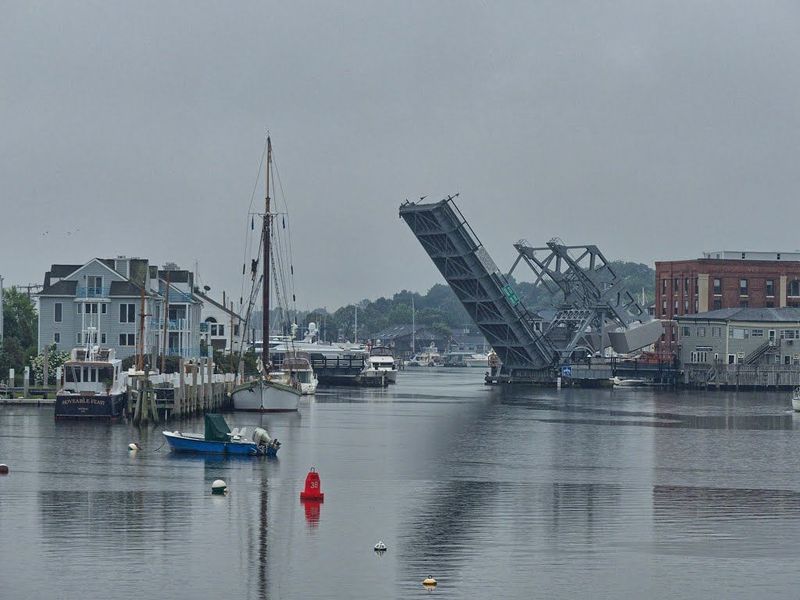
Maritime history flows through the veins of these twin coastal villages where tall ships once departed for whaling expeditions. Mystic Seaport Museum—the largest maritime museum in the United States—brings this seafaring heritage to life with historic vessels and a recreated 19th-century coastal village. The 1920s bascule bridge in downtown Mystic rises hourly to allow boats passage, stopping traffic and creating an impromptu community gathering as pedestrians pause to watch. Made famous by the 1988 film “Mystic Pizza,” the actual restaurant still serves slices to movie fans and locals alike. Neighboring Stonington Borough offers a quieter experience with its narrow streets lined with captain’s homes and secret gardens hidden behind stone walls. Commercial fishing boats still operate from Stonington Harbor, bringing fresh catch to dockside restaurants where diners watch the day’s bounty arrive.
10. Yorktown Beach, Virginia
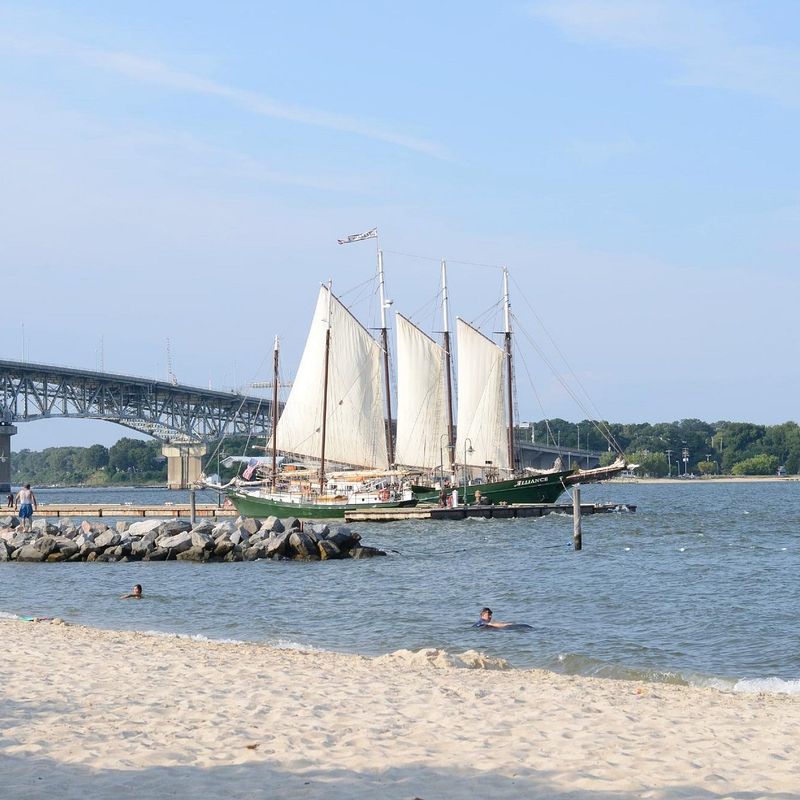
Revolutionary War history meets riverside charm in this small but significant coastal town. The Victory Monument stands tall above the York River, commemorating the decisive 1781 battle where American independence was essentially won. Unlike ocean beaches, Yorktown’s shoreline offers calm waters perfect for families with young children. The Riverwalk connects historic battlefields to waterfront restaurants where diners feast on Chesapeake Bay blue crabs while watching sailboats glide by. Colonial-era buildings house museums and shops along Main Street, where cobblestones have witnessed over two centuries of American history. Sunset brings a spectacular show as the light plays across the water and illuminates the George P. Coleman Memorial Bridge—the second-longest swing bridge in the United States—connecting Yorktown to Gloucester Point across the river.
11. Carmel-by-the-Sea, California
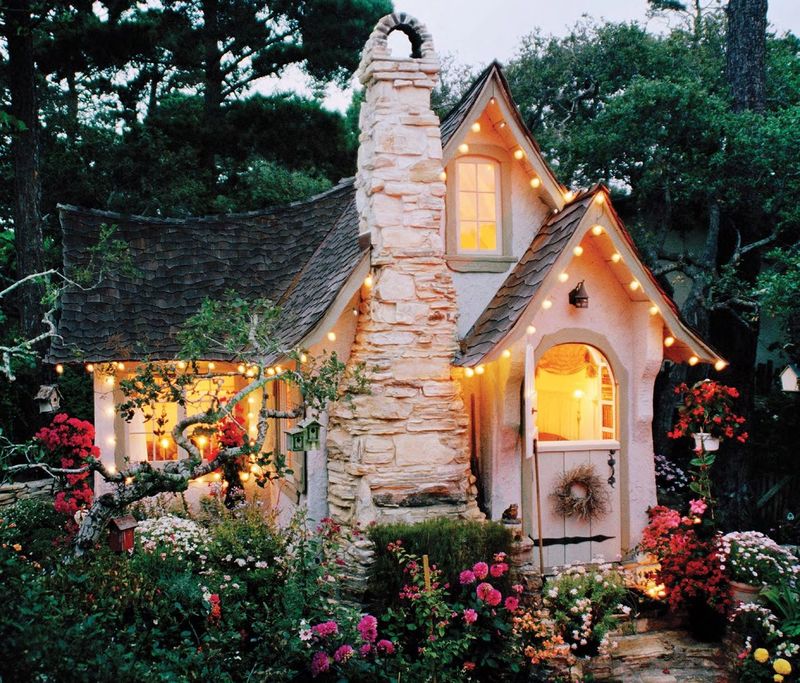
Fairytale cottages with names instead of addresses hide among twisted cypress trees in this artistic haven on California’s Monterey Peninsula. Former mayor Clint Eastwood helped put this one-square-mile village on the map, though it had already been attracting artists and writers since the early 1900s. Local ordinances prohibit street addresses, high heels on the uneven pavement, and chain restaurants—all preserving the town’s unique character. The white-sand beach curves gently along Carmel Bay, where surfers brave the chilly Pacific waters and dogs run freely off-leash, one of the few beaches in California allowing this freedom. Hidden passageways and courtyards reveal secret gardens, art galleries, and wine tasting rooms. Hugh Comstock’s whimsical “Hansel and Gretel” homes with their rolled eaves and rounded doors create the impression of stepping into a storybook illustration.
12. Laguna Beach, California
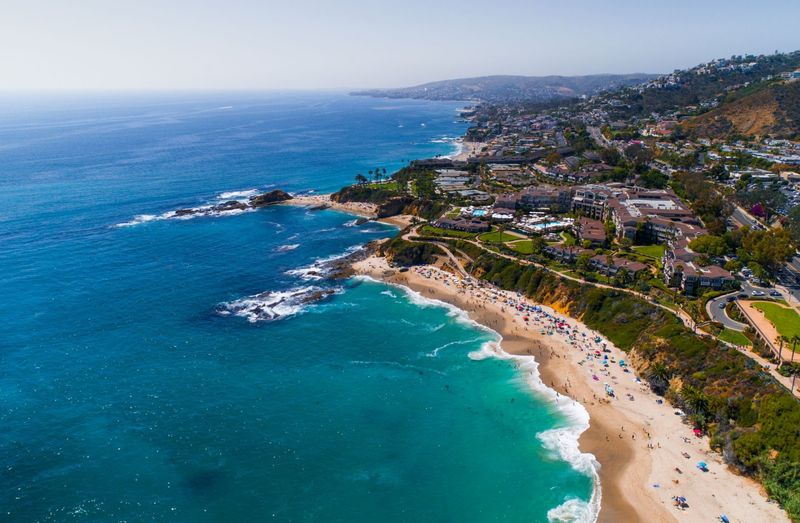
Artists discovered this coastal paradise in the early 1900s, drawn by the unique quality of light created when inland mountains meet ocean mist. Today, over 100 art galleries and studios dot the village, while the summer-long Festival of Arts and Pageant of the Masters celebrates this creative heritage. Dramatic coves carved into the coastline create a series of distinct beaches, each with its own personality. Tide pools at Shaw’s Cove reveal starfish and sea anemones, while surfers catch perfect waves at Thalia Street Beach. The 1,500-foot Main Beach boardwalk serves as the town’s living room, where locals gather for volleyball and sunset viewing. Hidden amid million-dollar homes sit historic beach bungalows from the town’s bohemian beginnings. Las Brisas restaurant occupies the former Victor Hugo Inn, where Hollywood stars of the 1920s would escape for romantic weekends away from studio scrutiny.
13. Half Moon Bay, California
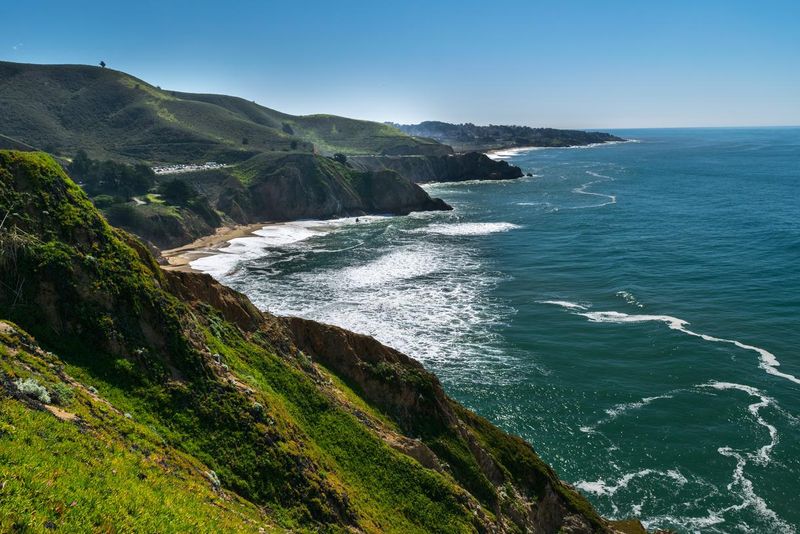
Morning fog rolls across fields where farmers grow some of the world’s most spectacular pumpkins—the annual Pumpkin Festival celebrates harvests exceeding 2,000 pounds! This agricultural heritage creates a refreshing contrast to the typical beach town experience. The crescent-shaped harbor that gives the town its name shelters colorful fishing boats that supply fresh catch to waterfront restaurants. Massive waves at Mavericks Beach create one of the world’s most challenging surf breaks, drawing elite surfers when winter swells exceed 25 feet. The historic Main Street feels transplanted from New England, with Victorian buildings housing artisanal shops and farm-to-table eateries. Just offshore, migrating gray whales pass so close to the bluffs that visitors can hear their thunderous exhalations. The Ritz-Carlton perches dramatically on the cliffs, while working-class fishermen maintain the authentic character of this coastal community.
14. Friday Harbor, Washington
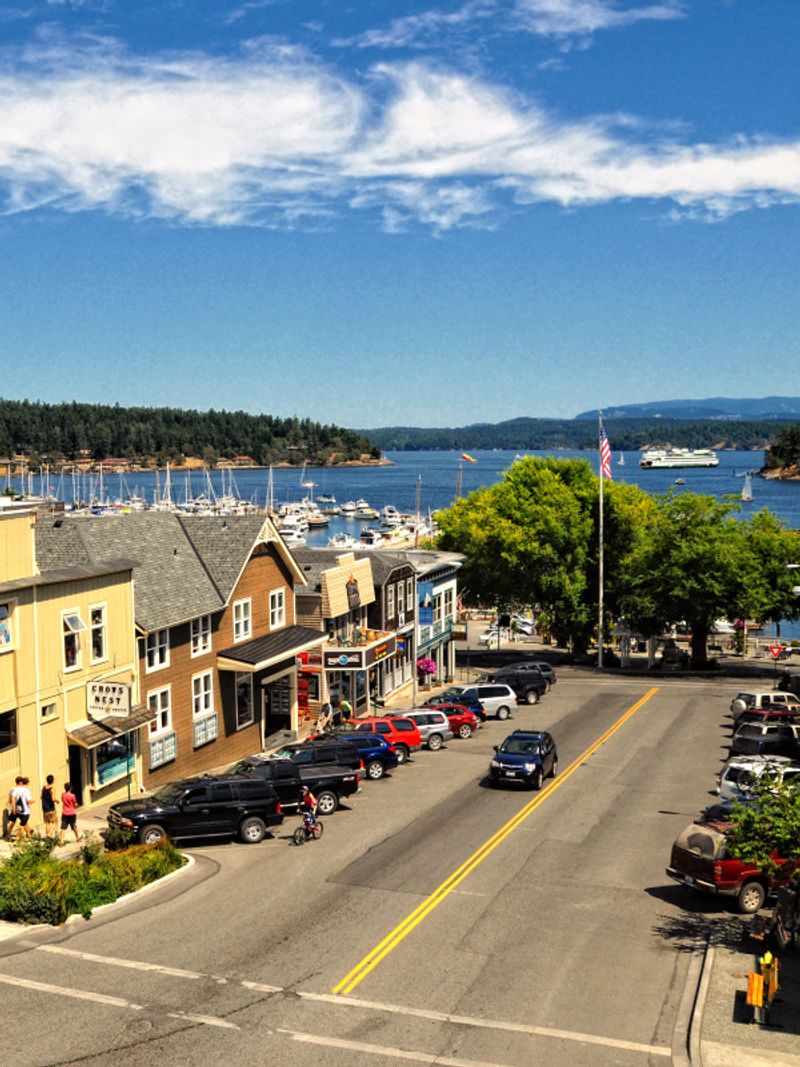
Accessible only by ferry, seaplane, or private boat, this San Juan Island gem preserves an unhurried island rhythm. Orcas frequently pass through the surrounding waters, making whale watching an everyday occurrence rather than a special excursion. The compact, walkable town rises from the harbor on a gentle hill, with historic buildings housing bookstores, bakeries, and maritime-themed boutiques. No stoplights interrupt the flow of island life, and deer wander freely through residential neighborhoods. Lavender farms perfume the air in summer, while winter brings cozy evenings in pubs where fishermen and software millionaires share tables without pretension. The Whale Museum educates visitors about the endangered Southern Resident orca population that calls these waters home. Despite being just 90 minutes from Seattle, Friday Harbor feels worlds away from city stress.
15. Cannon Beach, Oregon
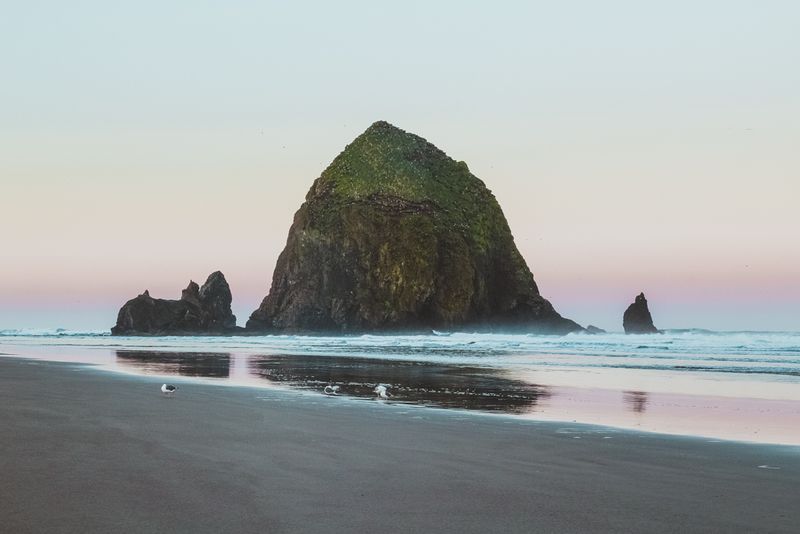
Haystack Rock rises 235 feet from the shoreline like a natural cathedral, home to colorful tufted puffins during summer months. This monolithic sea stack serves as the iconic symbol of Oregon’s most artistic beach town, where galleries outnumber grocery stores. Morning reveals miles of misty shoreline where agates and Japanese glass floats occasionally wash ashore—treasures for beachcombers who brave the frequently cool, foggy conditions. The surrounding temperate rainforest meets the Pacific in dramatic fashion at Ecola State Park, where scenes from “The Goonies” were filmed. Downtown maintains strict architectural standards that prevent chain stores from disrupting the village atmosphere. Mo’s Restaurant has served its famous clam chowder since 1951, warming visitors after windswept beach walks. During extreme low tides, the sea retreats to reveal colorful starfish and anemones in rocky tide pools around Haystack Rock.
16. Ketchikan, Alaska
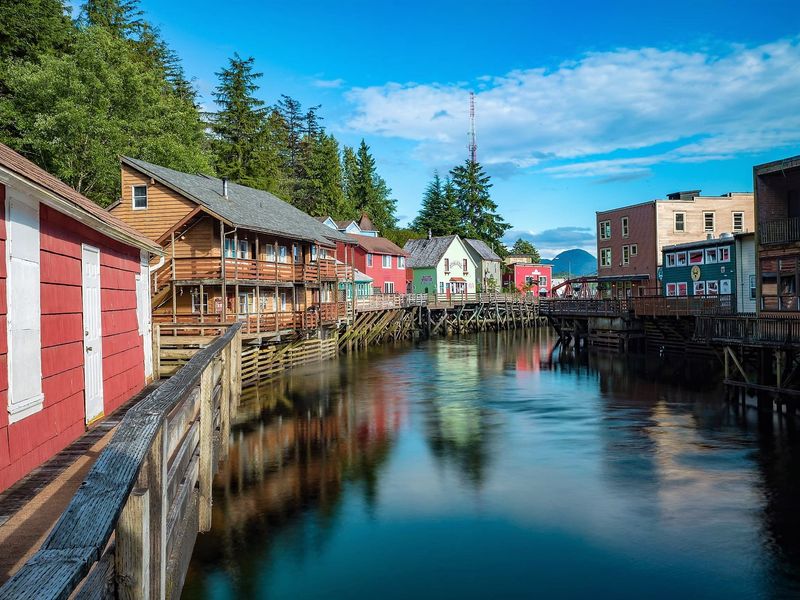
Known as Alaska’s “First City” and “Salmon Capital of the World,” Ketchikan clings to the mountainside along the Inside Passage. Wooden boardwalks and staircases connect the colorful buildings of Creek Street—once the town’s notorious red-light district during Prohibition, now home to art galleries and boutiques. Totem poles stand tall throughout town, showcasing the rich Tlingit, Haida, and Tsimshian heritage. Rain falls here over 230 days annually, creating the lush temperate rainforest that surrounds the community and earning it the nickname “the town where it rains on the parades.” Fishing boats bring in spectacular king salmon, while floatplanes buzz overhead, connecting remote communities. Eagles perch on pilings along the harbor, watching for fish scraps. The town’s personality shifts dramatically between winter’s quiet local rhythm and summer’s cruise ship crowds seeking authentic Alaskan experiences.
17. Capitola, California
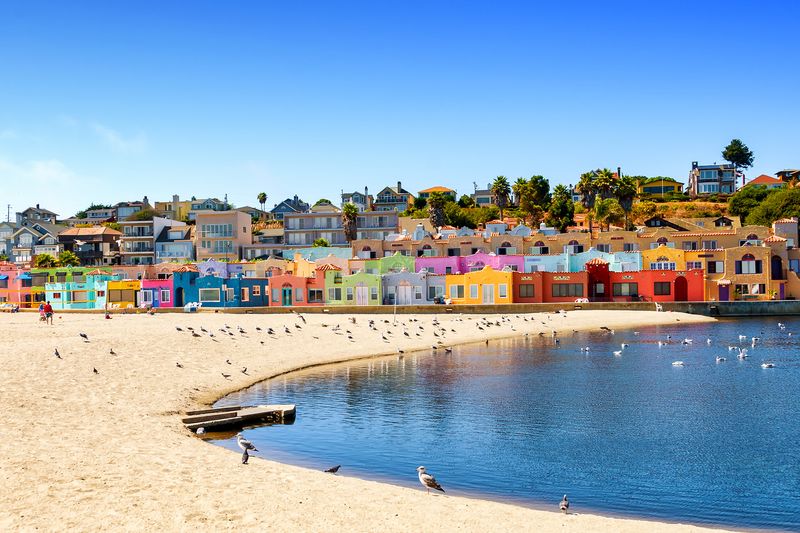
Rainbow-hued buildings known as the “Venetian Court” create California’s answer to Italy’s colorful coastal villages. Built in the 1920s as the state’s first condominium seaside resort, these Mediterranean-inspired bungalows now stand as the most photographed landmark in this laid-back surf town. The Capitola Wharf stretches into Monterey Bay, where fishing remains both recreation and livelihood. Unlike many California beach towns that grew around missions or military installations, Capitola was deliberately created as a seaside resort in 1869 when entrepreneur Frederick Hihn developed “Camp Capitola” as a beach getaway for inland residents. Soquel Creek flows into the sea here, creating a lagoon where children paddle in calm waters. The annual Begonia Festival transforms the creek into a parade route for flower-covered floats, celebrating the town’s former begonia-growing industry that once supplied blooms nationwide.
18. Santa Barbara, California
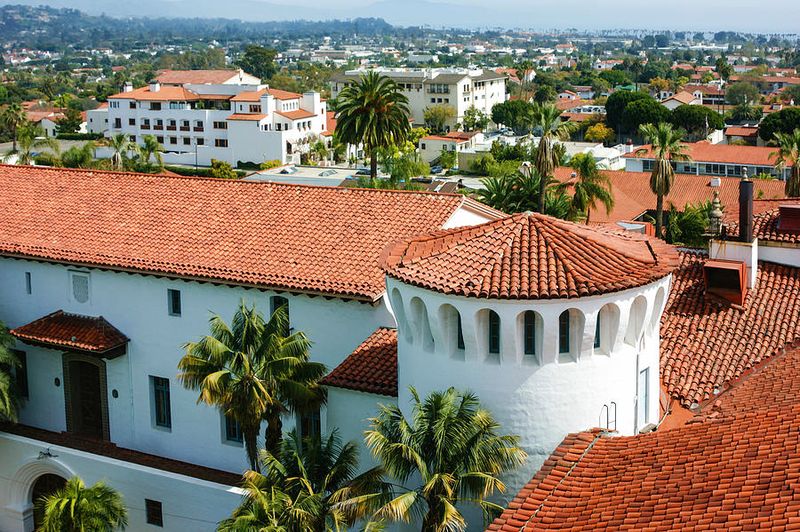
Nicknamed the “American Riviera,” Santa Barbara nestles between the Santa Ynez Mountains and the Pacific Ocean in a setting reminiscent of the Mediterranean coast. Spanish colonial architecture with distinctive red-tile roofs and white stucco walls creates a cohesive aesthetic rarely found in American cities. The historic mission stands as the “Queen of the Missions” for its exceptional beauty, while Stearns Wharf extends over the water offering panoramic views of Channel Islands National Park offshore. Palm trees line the waterfront, where the harbor shelters everything from humble fishing boats to luxurious yachts. The weekly farmers market brings together the bounty of surrounding agricultural lands and vineyards. A devastating 1925 earthquake led to the city’s architectural rebirth, with strict guidelines creating the cohesive Spanish Colonial Revival style that defines Santa Barbara today.
19. La Jolla, California
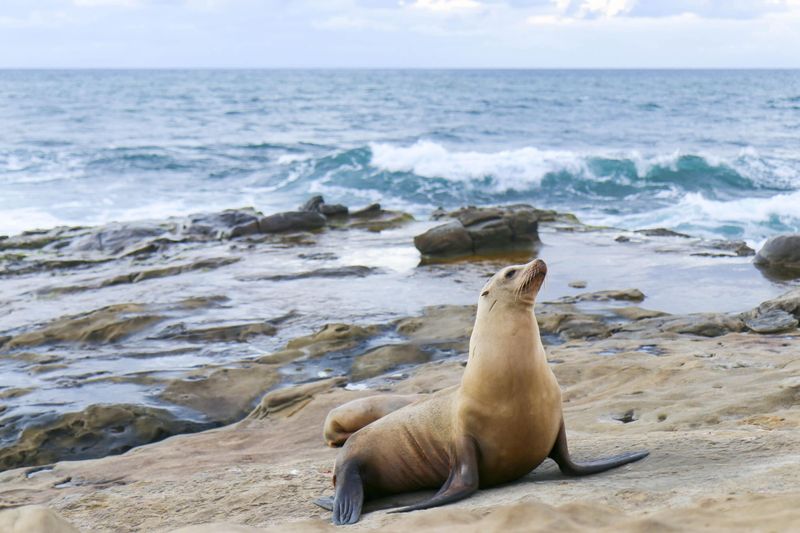
Sea lions have claimed prime real estate at La Jolla Cove, where they bask on sun-warmed rocks and entertain visitors with their antics. This upscale enclave north of San Diego combines natural wonders with sophisticated amenities. Seven sea caves punctuate the sandstone cliffs, with Sunny Jim’s Cave accessible through a century-old tunnel beginning inside a historic shell shop. Leopard sharks—harmless to humans—gather in the thousands during summer months, creating a unique swimming experience for brave snorkelers. The village climbs hillsides overlooking the Pacific, with Mediterranean-style mansions capturing ocean views. Dr. Seuss (Theodor Geisel) created many of his whimsical illustrations here, inspired by the unusual Torrey pine trees that grow naturally only in this area. The Scripps Institution of Oceanography established in 1903 continues pioneering marine research from its waterfront campus.
20. Santa Cruz, California
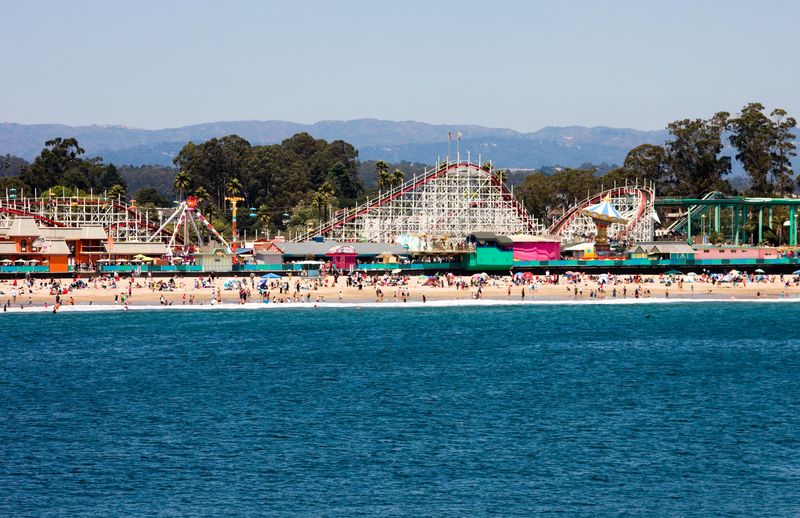
Surfing arrived in mainland America at this beach town in 1885 when three Hawaiian princes rode redwood boards at the mouth of the San Lorenzo River. Today, wetsuit-clad surfers still paddle out at Steamer Lane, where the Santa Cruz Surfing Museum chronicles this heritage from a lighthouse overlooking the break. The 1907 boardwalk features the Giant Dipper—one of the oldest wooden roller coasters in America—its screams and classic carnival music providing the soundtrack to beach days. Unlike many historic amusement parks that have modernized beyond recognition, Santa Cruz Boardwalk maintains its vintage charm. Nearby, ancient redwoods reach skyward in Henry Cowell State Park, creating the rare ability to surf and hike among giants in the same day. The town embraces its quirky personality with bumper stickers proclaiming “Keep Santa Cruz Weird”—a sentiment reflected in its street performers, eclectic shops, and bohemian atmosphere.

